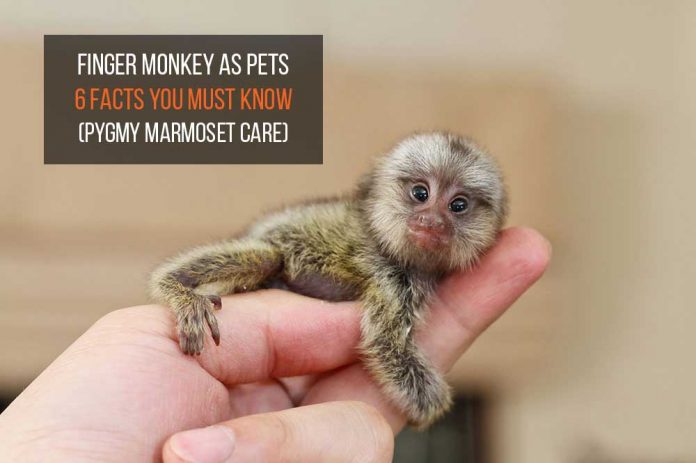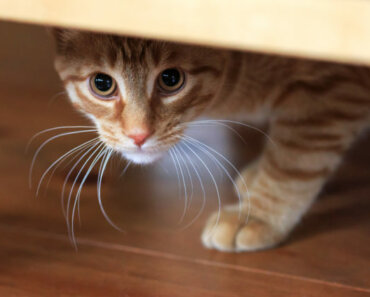Pygmy marmosets are also known as finger monkeys (you can use the two names interchangeably) or pocket monkeys, and for good reason. They are the smallest species of monkey in the world – and one of the smallest primates extant today. Rather than climbing up your arm or your leg, a mere finger may suffice for a climbing frame.
Native to the rainforests and jungles of the western Amazon Basin in South America, these tiny New World monkeys are increasingly making their way into our homes, and our hearts. Feeding mostly on gums, saps and resins (yep, they are technically gumnivores, though your pet marmoset won’t enjoy a stick of Extra), they are mostly found in evergreen and river-edge forests. They are highly social animals, living and operating in troops of 2 to 9 individuals.
Do they make good pets? Read this guide and judge for yourselves! Based on the information here, you can determine whether or not you think a pygmy marmoset, or finger monkey, is the right pet for you!
You should know, first of all, that they can be expensive in up front and ongoing costs. They are also illegal in approximately 20 US states. There are lots of things to consider.
With any luck, by the time you finish reading this, you will have a pretty good idea of whether or not owning a pygmy marmoset is the best decision for you, and for the marmosets themselves
#1: Pygmy marmoset legal issues: is it legal to own as a pet?
This is a good place to start. Before we dive into how to take care of pygmy marmosets, it’s important to know straight off the bat if they’re even legal to own!
Well, depending on where you live, the answer to that could be yes or no.
Here is a list of states in which it is (or at least could be) legal to own a finger monkey:
Alabama, Nebraska, Nevada, Montana, North Dakota, Kansas, Iowa, Missouri, Arkansas, Wisconsin, Illinois, Ohio, West Virginia, and Virginia: no permits needed – at time of writing. But double check before you buy! Laws change all the time.
Oklahoma, Pennsylvania, Rhode Island, Arizona, Indiana, Mississippi, and Tennessee: special permits are required to keep any type of primate or other type of wild or potentially dangerous animal. Apply for your permit from the state Department of Agriculture. Note: simply applying for a permit does not guarantee you will be granted one! Also, many of these states have partial bans, so you might get stuck at a policy level before even making an application.
Does your state appear on either of these lists? If so, you’re past the first hurdle! Note, however, that you might still need official permits and licenses to own a primate. Some states devolve responsibility to the individual county or municipality authorities. North Carolina is an example of a state in which there is no statewide ban, but where decisions are made on a county level.
Many states have introduced cover-all bans on primates, no matter the circumstances or how many times you make an appeal. In these states, the only people who can legally keep primates (or any other type of wild animal) are those running sanctuaries or educational animal exhibits. Even then, there are extensive criteria which need to be met. These include New York, New Jersey, California, Colorado, Connecticut, Georgia, Kentucky, Louisiana, Maine, Maryland, Massachusetts, New Hampshire, New Mexico, and Minnesota. So if you live in any of these states, consider settling for a cat.
#2: Finger monkey behavior: handling and bonding
Pygmy marmosets have a host of impressive talents, from rotating their heads all the round to jumping many times their own height – further than many monkeys larger than them! Here is an introduction to some of those behaviors.
Ability to rotate head 180 degrees
That’s right. Owls, step aside. There’s a new kid in town, with the uncanny ability to rotate its head through 180 degrees.
Crazy jumping ability
Pygmy marmosets can jump to a height that cannot easily be covered by other breeds of monkeys, even those much larger than the pygmy monkey. How high, exactly? Nearly 15 feet! For an animal that fits easily in the palm of your hand, that’s an impressive feat!
Bigger tails than bodies
The adult finger monkey usually reaches a total head-body length of 4.6-6.0 inches (117 to 152mm), while its tail is often significantly longer! Their tails can grow up to 6.8-9.0 inches (172-229mm).
Lucky if they make it to 6 months
Pygmy marmosets have a high mortality rate. Only 67% of pygmy marmosets make it to the age of 6 months. Nearly 80% of pygmy marmoset deaths occur within the first two months of life. Hold on tight, baby monkeys!
Aggressive tendencies in males
Finger monkeys, especially the males, tend to be aggressive when they reach adulthood. If you’re planning on keeping a finger monkey as a pet, you must be aware of this, and handle them accordingly! Pygmy marmosets are very active and often need the companionship of human beings and/or other finger monkeys.
Handling finger monkeys
Take care when handling adult male finger monkeys. They are unlikely to be able to physically hurt you, but the shock of a nip might lead to a reflex action. Given their small size and delicate bone structure, you could easily do quite a lot of damage to a pygmy marmoset without even meaning to!
Aside from that, be prepared to handle your pygmy marmoset frequently. As highly social animals, they require a lot of social stimulation and interaction, either from members of their posse, or you!
#3: How to care for a finger monkey
Finger monkeys are highly social animals. A model troop consists of 6 monkeys. So if you are thinking of adoption 1 finger monkey, think again! Take them on in pairs (or groups of more than 2!) to ensure they always have someone their own size to play with. This will take the pressure off you, and increase the likelihood of your pygmy marmoset settling into its new captive environment without a hitch.
Housing
Finger monkeys are physically active, too. They are avid and able climbers, and as such need vertical space in their enclosure. They also require a lot of sunlight – the most important vitamins in a pygmy marmoset diet as C and D3. These vitamins are essential for the health of a finger monkey (more on diet below). To provide D3, that means lots of sun, or a UV light.
A finger monkey’s cage should mimic its natural environment as close as possible. This means:
- Large cage with space to jump, climb and stay active
- Installing swings, artificial or real trees and a steady supply of clean (de-chlorinated) water
- Direct sunlight for at least a few hours a day, and a heat lamp or UV light if you cannot provide this
You should AVOID enclosures:
- That is wide and shallow because they will not provide your marmoset with enough vertical space in which to climb;
- That is very small because marmosets are social and physically active and like to be grouped together. One may be small, but two or three can take up a bit more space!
- That have opaque lids because they will not let in enough sunlight
- That is barren – spruce things up with some climbable objects!
- That is too dark.
Pygmy marmosets are not like dogs – they do not make great emotional support animals. So if you’re looking for a therapy animal, to cuddle when you’re down, you’re probably better off getting a dog!
Accessories
Real plants:
While real plants may come the closest to emulating the marmoset’s natural environment, it is vital that you now exactly where it came from, and that it is not carrying any nasty toxins or bacteria. Marmosets are prone to various diseases, and a new virus carried into their cage on some bark could be deadly. To avoid the risk, buy from a registered and reputable pet supply store.
Artificial plants:
Easy to purchase, maintain and clean, durable artificial plants can make your marmoset’s cage more interesting and vibrant. They provide opportunities for play and varied social interaction. To keep your marmosets on their toes, swap out one branch for another, or rearrange the items in the enclosure.
Swings & other climbable objects:
There are whole host of exciting objects available at most pet supply stores – hide boxes, swings, ladders and platforms. Mix these in with your real or artificial plants to liven things up for your pygmy marmoset(s).
#4: Pygmy marmoset diet: what do finger monkeys eat?
In the wild, pygmy marmosets have a specialized diet of tree gum. They gnaw holes in the bark of appropriate trees and vines with their special teeth. When the sap puddles up in the hole they’ve made, the monkey laps it up with its tongue.
Obviously this is a tricky situation to arrange in an enclosure in your home. Fortunately, you don’t have to!
Finger monkeys will happily munch on a wide range of foods, including fruits and vegetables, pasta, small insects, and rice. There are also special biscuits available which are fortified with vitamins D3 and C, protein and calcium. Look for these in your local pet supply store, or online, as they are the perfect snack for your finger monkey.
How to feed & feeding frequency
Finger monkeys are small, with high metabolic rates. As such they need to eat frequently, but only small amounts each time. Distribute biscuits, pieces of fruit and other tidbits around the enclosure once or twice a day. See for yourself how much, or how little, your monkeys eat, and what foods they prefer. Adjust accordingly, and clean out any bits of food that are left for more than a day.
#5: Pygmy marmoset cost: how much is a finger monkey?
This is probably where many of you will switch off from the idea of owning a finger monkey as a pet. They may be small, but they sure aren’t cheap! In fact, they may be one of the highest cost-per-ounce pets available.
A small, 3-ounce baby finger monkey will likely set you back somewhere between $1400 and $4000.
If that isn’t enough to put you off, consider the cost of food and enclosure, plus the regular expense of veterinarian fees. Regular vets are unlikely to welcome a pygmy marmoset into their clinic, as they bring with them all sorts of legal issues. So you will first need to find a vet who is prepared to help look after your marmoset at a moment’s notice, regularly, and over a period of up to 18 years.
What’s more, it is ill-advised to keep a finger monkey solo, so you will most likely have to fork out for two or three in one go! If this is all within your budget, then be my guest.
#6: Where can you buy a finger monkey?
These little fur-balls have been notoriously difficult to get hold of in the past. However, given the recent surge in popularity among alternative pet enthusiasts, the supply chains have kicked into gear. It is easier than it ever has been to buy a pygmy marmoset.
If you live nearby a large and well-supplied pet store, they may have pygmy marmosets in store. If not, you can look online, or call ahead to other pet stores in the vicinity. It is obviously preferable to buy your marmosets in person because you can check them over for health and establish a rapport with the pet store owner. Only buy from people you trust!
Conclusion
So, what do you think? Do pygmy marmosets make good pets? Do you have what it takes to look after multiple finger monkeys?
Based on the following three factors…
Maintenance – high or low? Pygmy marmosets require a lot of TLC, and ideally like to be placed in small groups. If you put together a pairing and they get on well with each other, that will lighten the load for you. If not, your marmoset might be quite high maintenance! They are attention seekers, and require a fairly high level of maintenance.
Handling – are they easy to handle? There is little evidence to suggest that pygmy marmosets are difficult to handle. Aside from the aggression often exhibited by males as they reach adulthood, they don’t pose a threat to your safety.
Cost – cost to buy pet, running cost: this is the clincher. They are expensive to buy, are almost always sold and bought in pairs, and may require expensive vet bills further down the line, plus vaccinations, jabs, etc. The overall cost can be divided up into base cost and ongoing costs, and summarized with overall cost. The base cost is high, and ongoing costs are moderately high (and not necessarily predictable).
I’d say the pygmy marmoset has great potential to be an excellent pet – if managed correctly, with diligence, patience and care. You might not be taking on the most emotionally understanding pet. As mentioned, these monkeys are not like dogs. They will not come to the rescue when you’re feeling blue!
They are also not like cats: do not expect them to roam the house, looking after themselves and occasionally rolling over and asking for food. They will hound you for attention, and let you know if they are not getting enough of it!
However, they have the cute factor, and will wow your friends with their incredible minuteness, and fascinating claws.
That’s all for now. What do you think? Is the pygmy marmoset for you? Have you ever held one, and did it make your heart melt?
As always, we’d love to know your thoughts and stories. Share this guide with your friends and family, so they too can share the joy that is the adorable pygmy marmoset.



























